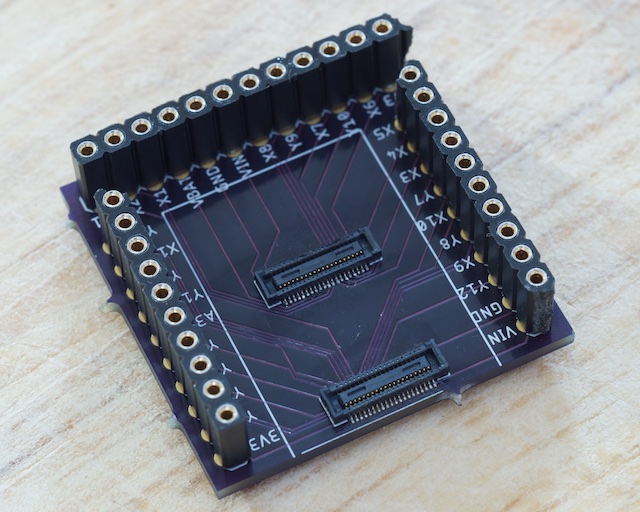Elegant Physical Config for Pyboard D
Re: Elegant Physical Config for Pyboard D
I had no problems getting them from the local electronic store. It looks like a standard item.
- pythoncoder
- Posts: 5956
- Joined: Fri Jul 18, 2014 8:01 am
- Location: UK
- Contact:
Re: Elegant Physical Config for Pyboard D
Hi Robert, I'm unsure what you meant by this. If it's an offer to let me have one, it would be most useful and I'd be very glad of it
Peter Hinch
Index to my micropython libraries.
Index to my micropython libraries.
Re: Elegant Physical Config for Pyboard D
Hi Peter, see my PM
-
kesterlester
- Posts: 23
- Joined: Sat Nov 17, 2018 10:04 pm
Re: Elegant Physical Config for Pyboard D
My first and only foray into pyboard D tinkering went straight to a double wbus connection design. Soldering the damn things was the hardest bit of soldering I've ever had to do. May not try to do so ever again.
Re: Elegant Physical Config for Pyboard D
Hi all,
I understand Peter's reluctance to design a DIP32 based on the WBUS connectors, but in case someone finds it useful, here's my attempt at something like that: https://github.com/mdaeron/pybd-breakout. The soldering wasn't too hard using low-temperature solder paste, an adjustable heating plate I had in the lab, and a toy binocular microscope (cf before and after pictures in the github readme).

I would also like to test something with 0.05" pitch connectors, but I don't want to solder anything to the pyboard. Is there a clever way to ensure good electrical contact with the pyboard pins without soldering pin headers?
- Mathieu
I understand Peter's reluctance to design a DIP32 based on the WBUS connectors, but in case someone finds it useful, here's my attempt at something like that: https://github.com/mdaeron/pybd-breakout. The soldering wasn't too hard using low-temperature solder paste, an adjustable heating plate I had in the lab, and a toy binocular microscope (cf before and after pictures in the github readme).

I would also like to test something with 0.05" pitch connectors, but I don't want to solder anything to the pyboard. Is there a clever way to ensure good electrical contact with the pyboard pins without soldering pin headers?
- Mathieu
- pythoncoder
- Posts: 5956
- Joined: Fri Jul 18, 2014 8:01 am
- Location: UK
- Contact:
Re: Elegant Physical Config for Pyboard D
That's very nice. I've always been amazed that it's possible to align the wbus connectors with the required degree of precision.
I don't know a way to connect without soldering. Robert's adaptor works very well for my purposes, but I was happy soldering to one of my Pyboards. I plan to get some more adaptors made to his design.
I don't know a way to connect without soldering. Robert's adaptor works very well for my purposes, but I was happy soldering to one of my Pyboards. I plan to get some more adaptors made to his design.
Peter Hinch
Index to my micropython libraries.
Index to my micropython libraries.
Re: Elegant Physical Config for Pyboard D
Aligning the connectors was also my concern. Not that I even tried to make such a board. But in the way @mathieu did it he could have soldered the connectors while attached to a pyboard D, because he heated up the adapter PCB from the bottom side. That way, the connectors are aligned.
The plus side of the simple adapter I made is the ability to use it on a breadboard. In an larger own board, you would use the W-Bus connector and have it soldered by the PCB maker.
The plus side of the simple adapter I made is the ability to use it on a breadboard. In an larger own board, you would use the W-Bus connector and have it soldered by the PCB maker.
Re: Elegant Physical Config for Pyboard D
Two comments: first, the WBUS pads are only 200 microns wide, so a reasonable visual alignment (using a binocular scope) is likely to be good to 20 microns or better, which is really not too bad. Second, I suspect the tolerances are much less strict when using thick/tall WCUS connectors (see viewtopic.php?f=20&t=6164), because adjusting to small misalignments requires more distributed strain on the plastic connectors.pythoncoder wrote: ↑Mon Feb 08, 2021 6:07 amI've always been amazed that it's possible to align the wbus connectors with the required degree of precision.
In another project I've mostly used low-profile connectors, and repeatedly ended up tearing the connectors away (on the custom board, not on the pyboard) after tens of plug/unplug cycles. I suppose this is due to a combination of misalignment-induced stress and the poor quality of my low-temperature solder.